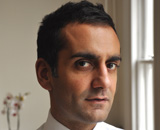I’ve been invited to participate in the Institute of Medicine‘s Roundtable on value and science driven healthcare. The focus of the all-day meeting is “continuous learning and the digital infrastructure for informed clinical decisions,” and the bit that I’m expected to speak about are the “functional needs for digital information at the point of care.”
What’s scaring me is that I want to tell them that “functional” needs are not what health leaders should be focussing on. I want to tell them that what really matters is getting doctors to trust information, and, although how the information functions is part of it, it’s only a small part of it.
In my experience, doctors only trust doctors when it comes to clinical matters. That’s the first and most important rule. It’s so important, in fact, that I am going to ask you to read it again: doctors only trust doctors.
I’ve met many non-doctors that hate that rule. They hate it so much they pretend it’s not there. I’ve watched health managers, IT experts, and policy makers all fool themselves into thinking they can influence what doctors do. They rarely—if ever—can.
Anyway, based on that rule, there are a bunch of sub-rules.
When I was a medical house officer it was clear that the gastroenterology registrar trusted other physicians before he trusted surgeons. This made all the sense in the world when you consider how many patients with “negative laparotomies” he was asked to see. When I was a surgical house officer, the nephrologists trusted the vascular surgeons because they worked closely to create anastomoses in patients in need of dialysis. They probably also trusted the transplant surgeons for much the same reason.
So the first sub-rule is that different specialists have different levels of trust for other specialists.
There are now about 180 guidance producers in the world. In my experience, Americans like to think that non-Americans want to practice like them but they’re wrong—although not always. For instance, in England I’ve come across respiratory physicians who will only follow guidance produced by the British Thoracic Society, as opposed to guidance from the American Thoracic Society; meanwhile cardiologists have tended to be more welcoming of guidance produced by the American Heart Association.
So the second sub-rule is that you have to understand what sources of information different specialists trust.
I’ve been involved in trying to convert content created for English clinical practice to Danish clinical practice. The English content was based on the regional biases of English doctors. I spent three days in Copenhagen meeting with a variety of doctors to understand their preferences and was quite surprised by how different they were to those of doctors in England. For instance, some American guidance producers were barely recognised by the Danes, while they put great stock in European guidance producers that were never mentioned by doctors in England.
So the third sub-rule is that clinicians in different countries display different levels of trust for the same sources of information.
One thing I did not test when I was in Copenhagen is whether the same specialty biases exist in Denmark as they do in England. I hypothesise that they do, but my experience has told me time and again not to presume. For instance, a friend of mine is a “physical medicine” doctor in Belgrade. From what I understand she is a cross between a senior physiotherapist and a sports medicine physician but, unless the specialty has been introduced in the last few years, I don’t believe we have such specialists in England. The existence of this “new” specialty likely influences the complex dynamic of trust between specialties.
Doctors—like all people—are also more trusting of people facing the same issues as them. For instance, general practitioners in tough, urban environments more keenly seek out the views of other general practitioners working in the same kind of environment. There is an instinctive logic to this.
So the fourth sub-rule is that doctors trust other doctors dealing with similar issues.
All of these sub-rules matter because knowledge nerds like me have learnt that creating standard forms of information rarely influences doctors’ behaviour. You have to tailor the information to the biases of the specialist. The point is made rather spectacularly by England’s National Institute of Health and Clinical Excellence (NICE); despite creating globally-revered, high-quality guidance, very little of it penetrates clinical practice. The problem is so glaring that the recent government strategy for health innovation seemed more about getting NICE guidance actually used than catalysing and distributing great new ideas.
Information needs to be endorsed by doctors—or clinical bodies—that doctors trust. Achieving this requires understanding the complex interplay of the sub-rules above. It’s only if you get this right does it matter how the information “functions” at the point of care. Indeed, if you get the trust right, the function needn’t be perfect; but well-functioning content that’s not trusted is a waste of everyone’s time and energy.
I’m going to tell the IOM all this. What are the odds they’ll ever invite me back?
Competing interests: The IOM are kindly paying my air fare to participate in the roundtable; they did not, however, commission this post. I provide consultancy to organisations to help them make better use of established knowledge, which can include helping them to establish trust in their information.
Pritpal S Tamber is the director of Optimising Clinical Knowledge Ltd, a consultancy that helps organisations improve how they use established clinical knowledge. He was previously the medical director of Map of Medicine Ltd, a company that creates clinical pathways to help health communities design services. He was the editorial director for medicine for BioMed Central Ltd and he was also the managing director of Medicine Reports Ltd. He has twice been an editor at the BMJ, the first time as the student editor of the Student BMJ.
